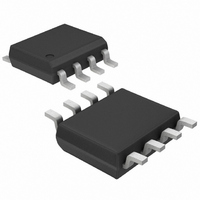MAX975ESA+T Maxim Integrated Products, MAX975ESA+T Datasheet - Page 11

MAX975ESA+T
Manufacturer Part Number
MAX975ESA+T
Description
IC COMPARATOR SNGL 8-SOIC
Manufacturer
Maxim Integrated Products
Type
General Purposer
Datasheet
1.MAX975EUA.pdf
(17 pages)
Specifications of MAX975ESA+T
Number Of Elements
1
Output Type
CMOS, Rail-to-Rail, TTL
Voltage - Supply
2.7 V ~ 5.25 V
Mounting Type
Surface Mount
Package / Case
8-SOIC (0.154", 3.90mm Width)
Lead Free Status / RoHS Status
Lead free / RoHS Compliant
Table 1. Programming
The MAX975/MAX977 single/dual comparators have
three operating modes, and use a +2.7V to +5.25V
single supply. The operating modes are as follows:
high speed, high speed with auto-standby, and low
power. Propagation delay is typically 28ns in high-
speed mode, while typical supply current is 250µA. In
low-power mode, propagation delay is typically 480ns
and power consumption is only 3µA. The auto-standby
feature switches into low-power standby for each
comparator with unchanging outputs in high-speed
mode. The timeout period, or the time that OUT_
must be idle (unchanged state) for the MAX975/
MAX977 to enter auto-standby, is adjustable by means
of an external capacitor. All inputs and outputs can tol-
erate a continuous short-circuit fault condition to either
rail. Internal hysteresis in high-speed mode ensures
clean output switching, even with slow-moving input
signals.
The MAX975 functional diagram shows two paralleled
comparators, a timing circuit, a transition detector, and
logic gates. The upper comparator is high speed, while
the lower comparator is a slower low-power compara-
tor. The dual MAX977 features independent timeout
adjustment. The following sections discuss the details
of operation.
Most high-speed comparators can oscillate in the linear
operating region because of noise or undesired para-
sitic feedback. This tends to occur when the voltage on
one input is equal to or very close to the voltage on the
other input. The MAX975/MAX977 have internal hys-
teresis to counter parasitic effects and noise.
The hysteresis in a comparator creates two trip points:
one for the rising input voltage and one for the falling
_______________Detailed Description
(falling edge)
LP
H
L
L
Hysteresis (High-Speed Mode Only)
______________________________________________________________________________________
t
t
ASB
ASB
= C
= C
INPUTS
STO_
STO
STO
X
L
x 10µs/pF
x 10µs/pF
Single/Dual, +3V/+5V Dual-Speed
Comparators with Auto-Standby
IDLE TIME
<t
t
ASB
ASB
X
X
input voltage (Figure 1). The difference between the trip
points is the hysteresis. When the comparators’ input
voltages are equal, the hysteresis effectively causes
one comparator input voltage to move quickly past the
other, taking the input out of the region where oscilla-
tion occurs.
Figure 1 illustrates the case where IN- has a fixed volt-
age applied and IN+ is varied. If the inputs were
reversed, the figure would be the same, except with an
inverted output.
The MAX975/MAX977’s auto-standby function operates
only in high-speed mode. The device enters auto-
standby when OUT_ remains unchanged for a prepro-
grammed timeout period. In auto-standby mode, the
low-power comparator is enabled while the high-speed
comparator is disabled and STAT_ goes high. The logic
state and sink/source capabilities of OUT_ remain
unchanged, but propagation delay increases to 480ns.
In this mode, the timing circuitry is powered down, and
the transition detector monitors the low-power com-
parator for a transition. When an output transition
occurs (OUT_ changes state), the timing circuitry is
Figure 1. Input and Output Waveforms, Noninverting Input
Varied
V
IN+
COMPARATOR
V
V
V
TRIP+
HYST
TRIP-
High speed
(Auto-standby enabled)
Auto-standby
High speed
(Auto-standby mode disabled)
Low power
OUTPUT
MODE
Auto-Standby Mode
V
V
V
V
OS
IN-
OH
OL
= V
= 0
OUTPUT
STAT
TRIP+
H
H
L
L
2
+ V
TRIP-
11








